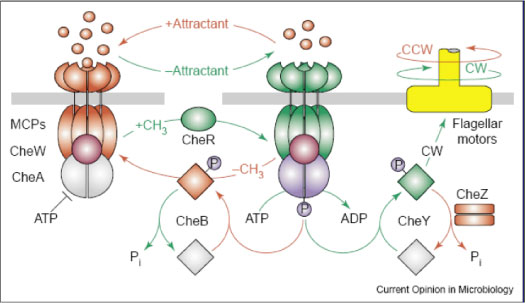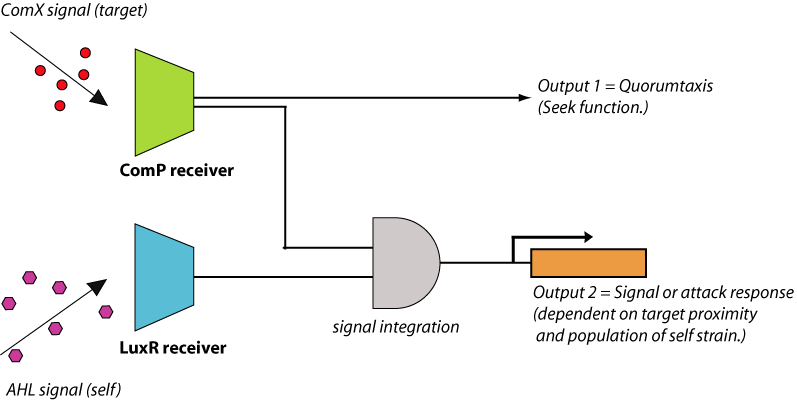PROJECT PROPOSAL
From 2006.igem.org
Contents |
INTRODUCTION
The objective of this project is to engineer Escherichia coli which are able to actively pursue and mark or eliminate another bacterial target. This system can be divided into three components: an input element, a processing element, and a response element. The input element will consist of a quorum sensing circuit which would allow specific detection of the bacterial target. The processing element will facilitate the signaling of this input into controlled responses. A number of different response elements can be conceived, to be used separately or in tandem: 1) integration into the chemotactic pathway of E. coli, allowing for directed mobilization towards the target, 2) reporter response at high pheromone concentrations to allow for visual identification of the target location (e.g., GFP production), and 3) an elimination response to produce molecules which are specifically lethal to the desired target.
SIGNIFICANCE
Successful completion of this project will demonstrate the ability to engineer complex behavioral phenotypes (predatory-prey behavior) into bacterial systems through the integration of biological modules. The phenotype of ‘quorumtaxis’ through the amalgamation of quorum-sensing and chemotaxis pathways would also be a unique demonstration of the novel circuits which can be achieved through the combined power of protein engineering methods and system biology paradigms. Furthermore, progress on this project would improve the tools available for engineering chemotactic responses to non-natural ligands.
In addition, a number of new parts will be made available to the iGEM registry. The most significant of these would be a ComP/Tsr hybrid receptor, which would allow the control of chemotaxis towards concentrations of a peptide pheromone. In addition, if the secondary strategy (outlined in Section III) is undertaken, Tsr-CW and Tsr-CCW receptor fragments would be added to the iGEM registry, allowing for transcriptional control of chemotaxis. The complete ComX quorum-sensing system may also be added to the iGEM registry; this would consist of a 2-gene construct (ComQ, ComX) for the sender device and a 2-gene construct for the receiver (ComP, ComA). Currently, the iGEM registry only contains AHL-based systems of the LuxR receiver family. The addition of a completely different quorum system would greatly expand the tools available for cell-to-cell communication.
RATIONALE
The quorum sensing system of gram negative bacteria is primarily mediated by the production and detection of acylated homoserine lactones (AHL) which accumulate in the extracellular medium as the cellular density increases. In contrast, gram positive bacteria such as Bacillus subtilis use excreted peptide pheromones to achieve a quorum response (Figure 1). Due to the considerable differences between these systems, crosstalk would not be expected to occur. We propose to engineer a response element in E. coli which is able to detect the peptide pheromone of gram positive cells and produce an intracellular signal.
The ComX quorum-sensing system in gram positive bacteria consist of the genes comX, comQ, comP, and comA (Table 1 and Figure 2) which have been shown to regulate genetic competence. These genes cluster occur as an operon in B. subtilis and their protein products have been characterized (1).
frame|center|Figure 2. Quorum response in gram-postitive bacteria.
The input element will consist of the ComX pheromone, which is a 10-residue peptide secreted extracellularly. In B. subtilis, ComX production requires the presence of comQ. The exact function of ComQ is not well understood. As ComX accumulates extracellularly and detection of cell density is mediated by a ComX receptor, ComP, which is a membrane-bound histidine kinase. ComP autophosphorylates upon binding to ComX and subsequently donates this phosphate to the downstream transcriptional activator, ComA. Once activated, ComA binds to specific binding sites in the regulatory regions of genes involved in genetic competence, antibiotic production, biofilm formation, swarming motility, and membrane secretion (Comella and Grossman, 2005).
A variety of processing elements can be integrated at the genetic level to obtain either simple gradient responses, stable biphasic switches (toggle switch) or integration with another input (AND gates). Many of these modules have been constructed and tested in various iGEM projects. The usage of these various circuits to modulate the system response can be modeled to characterize the dynamics of the genetic circuitry and fine-tuned during empirical testing of the system.
Chemotaxis in bacteria has been extensively studied as a model system for receptor signaling and intracellular signal transduction. To actively seek energy sources or optimal physicochemical environments, bacteria such as E. coli employ a system of alternating tumbling and swimming behaviors. Detection of an extracellular chemical signal produces a swimming phenotype (CCW flagellar rotation); a decrease in the signal induces a tumbling response (CW). The bacterium thus traces out a path similar to a ‘random walk,’ which produces movement in the direction of increasing attractant. Feedback control by methylation of the receptor proteins restores sensitivity to the environmental input by modulating phosphorylation activity. This allows the cell to detect attractant gradients in space as well as time. Figure 3 shows a diagram of chemotaxis from Parkinson, et al., 2005 (2). The chemotaxis system has also been shown to be essential for swarming motility in E. coli(3).
By integrating quorum-sensing and chemotactic pathways, it is possible to engineer a ‘quorumtaxis’ system, whereby a bacterium can sense the quorum pheromone of another species and move in that direction. To date, there have been no published results of engineered quorumtaxis systems. Construction of a functioning quorumtaxis system would be a significant innovation that demonstrates the power of developing a novel complex phenotype from pre-existing bacterial components. This can be done by integration of the ComX receiver system composed of ComP/ComA with the chemotaxis system of E.coli (figure 4). This engineered E. coli will begin to migrate towards gram positive cells (e.g., B. subtilis) due to the presence of extracellular ComX pheromone produced by these cells. Also, by adding the AHL quorum-sensing system to the E. coli cells and integrating the AHL and ComX detection systems together, it would be possible to produce an output which is dependent on both the proximity to the prey cells and the density of the predator strain.
The difficult aspect of this proposed project would be to construct and optimize the quorumtaxis pathway. Flagellar response to the presence of extracellular ComX can be engineered in a number of ways, all of which focus on the integration of signaling pathways between the B. subtilis ComXP and the E. coli chemotaxis system, both shown in Figure 5.
Strategy 1. ComP-Tsr chimeric receptor.
A commonality shared by the ComP-ComA system and the bacterial chemotaxis system is that they are both two-component signaling systems, as shown in Figure 5 (4). In such signaling pathways, an extracellular signal is detected by a membrane receptor, which then activates a signaling cascade, culminating in transcription or phenotypic output. The similarity of the ComP and MCP signaling systems allow for the construction of a hybrid two-component signal-transduction system which contains the extracellular ComP domain (ComX-binding) and the cytoplasmic signaling domains of the chemotaxis receptor Tsr. The engineering of chimeric proteins has been demonstrated for a number of two-component receptors. The modular domain architecture of these receptors has been shown to facilitate swapping of the the extracellular ligand binding domains or the cytoplasmic signaling domains. Table 2 lists a number of successfully engineered hybrid receptors.


